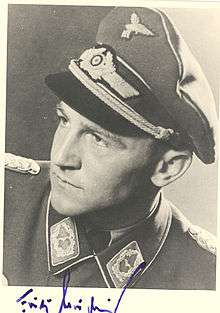Fritz Losigkeit
| Fritz Losigkeit | |
|---|---|
 Fritz Losigkeit | |
| Born |
17 November 1913 Berlin-Tegel |
| Died |
14 January 1994 (aged 80) Hünxe |
| Allegiance |
|
| Service/branch |
|
| Rank | Major |
| Commands held | I./JG 1, JG 51, JG 77 |
| Battles/wars |
|
| Awards |
Spanish Cross in silver with swords Knight's Cross of the Iron Cross |
| Other work | Politician |
Fritz Losigkeit (17 November 1913 – 14 January 1994) was a German World War II Luftwaffe Flying ace and recipient of the Knight's Cross of the Iron Cross. The Knight's Cross of the Iron Cross was awarded to recognise extreme battlefield bravery or successful military leadership. He held the position of Geschwaderkommodore of fighter wing Jagdgeschwader 51 and Jagdgeschwader 77.
Life
Losigkeit joined the Prussian State Police Academy and was eventually selected for flight training. After graduation, he was assigned to Jagdgeschwader (Fighter Wing) 132, the famous Richthofen Wing. In March 1938, he was assigned to Jagdgruppe 88 with the Condor Legion, flying the Heinkel He 51 during the Spanish Civil War. He was shot down by 20 mm antiaircraft artillery on 31 May 1938 and was captured and held prisoner of war until he escaped in February 1939. For his actions during the Civil War he was awarded the Spanish Cross in silver with swords.
He was then assigned to JG 26 flying the Messerschmitt Bf 109. Losigkeit scored his first victory on 28 May 1940 during the Battle of France, a Spitfire over Calais. As the air war turned to England, he achieved four more victories to become an Flying ace by 15 September 1940. For the next 8 months Losigkeit commanded 2nd Staffel of JG 26 and flew more than 100 combat missions.
In May 1941 he was reassigned as a diplomatic courier to Japan. Until January 1942 he advised on German air combat tactics with Imperial Japanese Army Air Force pilots flying the Nakajima Ki-44 against several examples of the Messerschmitt Bf 109 fighter shipped to Japan for evaluation. Wanting to rejoin the European war, he made the voyage back to Germany via the German blockade-runner MSS Elsa Essberger.

Travelling 23,300 nautical miles (43,200 km), Losigkeit arrived in time to form Sonderkommando Losigkeit on the orders of General of Fighters Adolf Galland. Losigkeit conducted fighter operations over Norway in support of the Navy and the battleship Scharnhorst. After completing this special operation, he took command of IV./JG 1 at Berlin-Werneuchen, which later became I./JG 1. Deployed to bases in the West, his unit flew missions against de Havilland Mosquito reconnaissance aircraft and USAAF heavy bomber formations attacking targets in Germany. In June 1943 Major Losigkeit commanded III./JG 51 "Mölders" flying the Bf-109 in the Orel area of the Eastern Front. Fighting during the Battle of Kursk in July 1943, his unit then covered the retreat of the German Army.
On 1 April 1944 he became Geschwaderkommodore of JG 51 and continued to fight against ever increasing odds as the Russians advanced. Awarded the Knight's Cross in April 1945, he ended the war as Geschwaderkommodore of JG 77 in Czechoslovakia.Losigkeit was credited with around 750 combat missions, claiming some 68 air victories.
After the war Losigkeit returned to civilian life, turning his attention to politics and business. He was a secretary in the administration of the Free Democratic Party (FDP) in 1946. From 1946 until 1978, he served as a business representative and a marketing manager in a utilities company.
Awards
- Spanish Cross in silver with swords
- Iron Cross (1939) 2nd and 1st Class
- Ehrenpokal der Luftwaffe on 11 October 1943 as Major and Gruppenkommandeur[1]
- German Cross in Gold on 17 October 1943 as Major in III./JG 51[2]
- Knight's Cross of the Iron Cross on 28 April 1945 as Major and Geschwaderkommodore of JG 51 "Mölders"[3][4]
References
Citations
Bibliography
- Fellgiebel, Walther-Peer (2000) [1986]. Die Träger des Ritterkreuzes des Eisernen Kreuzes 1939–1945 — Die Inhaber der höchsten Auszeichnung des Zweiten Weltkrieges aller Wehrmachtteile [The Bearers of the Knight's Cross of the Iron Cross 1939–1945 — The Owners of the Highest Award of the Second World War of all Wehrmacht Branches] (in German). Friedberg, Germany: Podzun-Pallas. ISBN 978-3-7909-0284-6.
- Obermaier, Ernst (1989). Die Ritterkreuzträger der Luftwaffe Jagdflieger 1939 – 1945 [The Knight's Cross Bearers of the Luftwaffe Fighter Force 1939 – 1945] (in German). Mainz, Germany: Verlag Dieter Hoffmann. ISBN 978-3-87341-065-7.
- Patzwall, Klaus D.; Scherzer, Veit (2001). Das Deutsche Kreuz 1941 – 1945 Geschichte und Inhaber Band II [The German Cross 1941 – 1945 History and Recipients Volume 2] (in German). Norderstedt, Germany: Verlag Klaus D. Patzwall. ISBN 978-3-931533-45-8.
- Patzwall, Klaus D. (2008). Der Ehrenpokal für besondere Leistung im Luftkrieg [The Honor Goblet for Outstanding Achievement in the Air War] (in German). Norderstedt, Germany: Verlag Klaus D. Patzwall. ISBN 978-3-931533-08-3.
- Scherzer, Veit (2007). Die Ritterkreuzträger 1939–1945 Die Inhaber des Ritterkreuzes des Eisernen Kreuzes 1939 von Heer, Luftwaffe, Kriegsmarine, Waffen-SS, Volkssturm sowie mit Deutschland verbündeter Streitkräfte nach den Unterlagen des Bundesarchives [The Knight's Cross Bearers 1939–1945 The Holders of the Knight's Cross of the Iron Cross 1939 by Army, Air Force, Navy, Waffen-SS, Volkssturm and Allied Forces with Germany According to the Documents of the Federal Archives] (in German). Jena, Germany: Scherzers Militaer-Verlag. ISBN 978-3-938845-17-2.
External links
- "Fritz Losigkeit". World War 2 Awards.com. Retrieved 12 June 2013.
| Military offices | ||
|---|---|---|
| Preceded by Oberstleutnant Karl-Gottfried Nordmann |
Commander of Jagdgeschwader 51 Mölders 1 April 1944 – 31 March 1945 |
Succeeded by Major Heinz Lange |
| Preceded by Major Siegfried Freytag |
Commander of Jagdgeschwader 77 Herz AS 1 April 1945 – May, 1945 |
Succeeded by none |